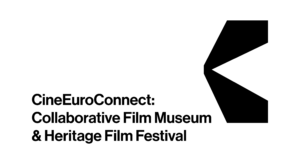Title: Imperfect circles
Artist: Iulia Enkelana
Country: Romania
Iulia Enkelana (pseudonym of Iulia-Maria Kyçyku) was born in Bucharest in an Albanian and Romanian family. She graduated from the Faculty of Theatre and Film at Babeș-Bolyai University, with a bachelor’s degree in Theatre Studies. Currently, she is pursuing a master’s program in Society, Multimedia, and Performance – Visual Studies at the Center of Excellence in Image Studies at the University of Bucharest.
Iulia has created numerous remarkable short films, including “MATCH” (2023), “Prenaissance” (2023), “I had to pawn the diamond” (2020, ex aequo winner of the SIMULTAN Festival, selected at Prague International Indie Film Festival and Retrospective of Jupiter online platform), “She blinks” (2021, which was a finalist at the Cefalù Film Festival and selected for prestigious festivals such as Her International Film Festival, the online platform Think Shorts, Lift Off Global Network, and the Techirghiol Art Festival). Additionally, she crafted the short film “The Absent City” in 2018, which was chosen for screenings at the Ridgefield Independent Film Festival and the Inshort Film Festival in 2019, reaching the semifinals of the Newark IFF Youth Festival.
As an artist, Iulia explores the subtleties of the connections between words and images. Her interests revolve around themes such as identity, individual freedom, and the complex relationship with memory.
Artist’s Vision:
I would like to make a tribute to the underground and avant-garde filmmakers, to the creators that dared to make films outside the system, who were dedicated to their craft and found their own cinematic language regardless of all the obstacles and so-called rules of filmmaking. I am strongly inspired by Jonas Mekas, for his tender addiction to documenting his life and for his approach to memory and beauty, by Maya Deren, for her manner of dealing with time, space and dreams, as well as by Georges Meliès, for his handmade sets and innovative techniques. I would like to focus on this side of the history of cinema, on the work of those who love(d) cinema so much that nothing could stop them from making their films. An alternative history of cinema, an alternative canon composed of films often labeled as amateur or experimental due to their unconventional aesthetic and cinematic language.
Therefore, the work I am proposing is a short film about the process of completely independent, low/no-budget filmmaking; failed shots caused by the sudden change of sunlight, dangerous experiments like burning paper in your own home and the solutions you have to find. I would like to show this playful, stubborn, difficult, partly clumsy, constrained and essentially creative side of filmmaking; the beauty and challenges of this craft, the making of the puzzle pieces.
I always document my work and rarely delete even the unsuccessful shots, so I would use material from my own archive, ‘behind the scenes’ of completed, ongoing and abandoned projects. I wouldn’t structure it as a before & after film – I don’t want to show the results, only what’s behind the visual metaphors, the abstract images and the trompe-l’oeils; like telling an intimate secret publicly.
The focus of this artist is films made outside the system. It’s a particularly interesting subject for an artist from a part of the world where state-sanctioned narratives were the only ones to reach mainstream audiences for decades. However, the large sums of money needed to make most cinema means that the output is nnot controlleede by the artists, no matter how democratic or free the citizens of a country believe they are. When cinema is made by corporations whose existence is justified by profits, purity of vision is rarely uncompromised.
Therefore the work of underground and underrepresented artists is uniquely interesting because it has developed uncontaminated by either censorship or commercial pressures. However the lack of resources, sometimes the lack of a sound training in film technique or a well-developed grasp of the language of cinema can also render the works of inaccessible to the general public.
By choosing to explore and celebrate what she describes as “this playful, stubborn, difficult, partly clumsy, constrained and essentially creative side of filmmaking” Iulia Enkelana invites the audience to look again at what might have been obtuse, obscure, incomprehensible or alienating. – Mary Kate O’Flanagan, curator
